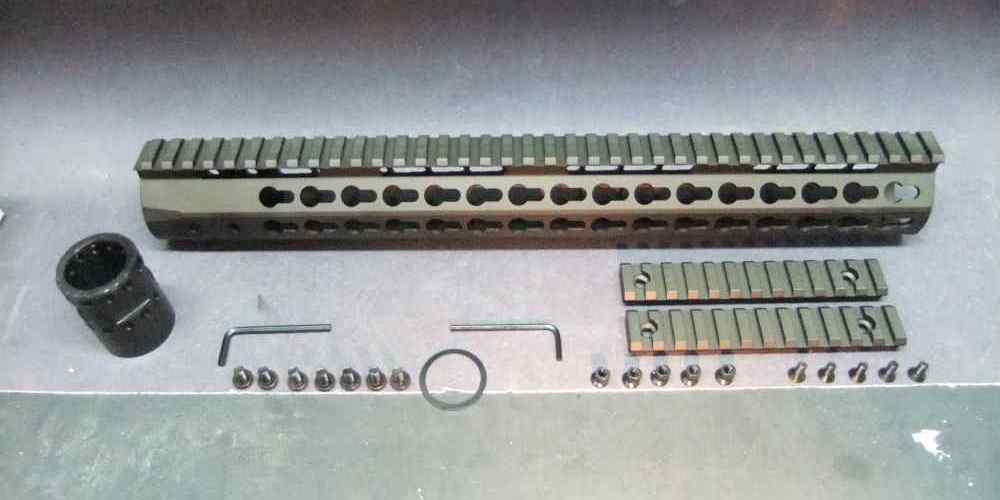Protect your AR15, repair cracks and damage on your handguard.
Identifying Common Hazards in AR15 Handguards
The AR15 is a popular rifle among gun enthusiasts for its versatility and customization options. One key component of the AR15 is the handguard, which serves as a protective covering for the barrel and gas system. However, over time, handguards can become damaged or develop cracks, posing potential hazards to the user. In this article, we will discuss how to identify common hazards in AR15 handguards and provide tips on repairing cracks and damage. One of the most common hazards in AR15 handguards is cracks. Cracks can develop due to a variety of reasons, including rough handling, impact damage, or exposure to extreme temperatures. It is important to regularly inspect your handguard for any signs of cracks, as they can compromise the structural integrity of the rifle and pose a safety risk. To identify cracks in your ar15 handguard, carefully examine the surface of the handguard for any visible signs of damage. Look for hairline fractures, chips, or any areas where the material appears to be separating. If you suspect that your handguard has a crack, it is important to address the issue promptly to prevent further damage. Repairing cracks in AR15 handguards can be a straightforward process if caught early. One common method for repairing cracks is to use a high-strength epoxy adhesive. Begin by cleaning the area around the crack with a solvent to remove any dirt or debris. Apply the epoxy adhesive to the crack and use a clamp to hold the two sides of the crack together while the adhesive sets. Allow the adhesive to cure according to the manufacturer’s instructions before using the rifle again. In addition to cracks, another common hazard in AR15 handguards is damage to the mounting system. The mounting system is responsible for securing the handguard to the rifle and ensuring that it remains in place during use. If the mounting system becomes damaged or loose, it can cause the handguard to shift or become unstable, posing a safety risk to the user. To identify damage to the mounting system, check for any loose screws, missing hardware, or signs of wear and tear. If you notice any issues with the mounting system, it is important to address them promptly to prevent further damage. In some cases, you may need to replace the mounting hardware or seek professional assistance to ensure that the handguard is properly secured. Regular maintenance and inspection of your AR15 handguard are essential for ensuring the safety and performance of your rifle. By identifying common hazards such as cracks and damage to the mounting system, you can take proactive steps to address these issues and prevent potential safety risks. Remember to follow proper repair procedures and seek professional assistance if needed to ensure that your AR15 handguard remains in optimal condition.
Steps to Repair Cracks in AR15 Handguards
The AR15 is a popular firearm among gun enthusiasts for its versatility and customization options. One key component of the AR15 is the handguard, which serves as a protective covering for the barrel and gas system. However, over time, handguards can develop cracks and other damage that can compromise the functionality and safety of the firearm. In this article, we will discuss the steps to repair cracks in AR15 handguards to ensure that your firearm remains in top condition. The first step in repairing cracks in AR15 handguards is to assess the extent of the damage. Inspect the handguard carefully for any visible cracks or signs of wear and tear. Cracks can occur due to a variety of reasons, such as rough handling, impact, or exposure to extreme temperatures. It is important to identify the cause of the damage to prevent further cracks from developing in the future. Once you have identified the cracks in the handguard, the next step is to determine the best method for repairing them. There are several options available for repairing cracks in AR15 handguards, including using epoxy resin, fiberglass cloth, or heat-resistant tape. Each method has its own advantages and disadvantages, so it is important to choose the one that best suits your needs and skill level. If you choose to repair the cracks using epoxy resin, start by cleaning the damaged area with a solvent to remove any dirt or debris. Mix the epoxy resin according to the manufacturer’s instructions and apply it to the crack using a small brush or applicator. Make sure to spread the resin evenly over the crack and allow it to dry completely before handling the handguard again. Another option for repairing cracks in AR15 handguards is to use fiberglass cloth. Cut a piece of fiberglass cloth to fit over the crack and apply a layer of epoxy resin to the damaged area. Place the fiberglass cloth over the resin and press it down firmly to ensure a secure bond. Allow the resin to dry completely before sanding down any rough edges or excess material. If you prefer a quick and easy solution, you can also use heat-resistant tape to repair cracks in AR15 handguards. Simply cut a piece of tape to fit over the crack and apply it to the damaged area. Heat-resistant tape is a temporary solution and may not provide a long-lasting repair, so it is important to monitor the handguard for any signs of further damage. In conclusion, repairing cracks in AR15 handguards is a simple and straightforward process that can be done at home with the right tools and materials. By following these steps, you can ensure that your firearm remains in top condition and continues to perform at its best. Remember to always handle firearms with care and respect to prevent damage and ensure your safety while shooting.
How to Address Damage in AR15 Handguards
The AR15 is a popular rifle among gun enthusiasts for its versatility and customization options. One key component of the AR15 is the handguard, which serves as a protective covering for the barrel and also allows for the attachment of accessories such as lights, lasers, and grips. However, over time, handguards can become damaged due to wear and tear, mishandling, or accidents. One common issue that AR15 owners may encounter is cracks or other damage to the handguard. In this article, we will discuss how to identify and repair cracks and damage in AR15 handguards. Cracks in handguards can be caused by a variety of factors, including rough handling, impacts, or exposure to extreme temperatures. It is important to inspect your handguard regularly for any signs of damage, as cracks can compromise the structural integrity of the handguard and potentially lead to more serious issues down the line. If you notice any cracks or other damage, it is important to address them promptly to prevent further deterioration. To repair cracks in AR15 handguards, you will need a few basic tools and materials. First, you will need to remove the handguard from the rifle to assess the extent of the damage. Once you have removed the handguard, carefully inspect it for any cracks or other signs of damage. If you notice any cracks, you can begin the repair process by cleaning the area around the crack with a solvent to remove any dirt or debris that may be present. Next, you will need to fill the crack with a suitable adhesive or epoxy. There are many different types of adhesives and epoxies available on the market, so be sure to choose one that is specifically designed for use on firearms and can withstand high temperatures. Apply the adhesive or epoxy to the crack, making sure to fill it completely and evenly. Use a clamp or other tool to hold the crack closed while the adhesive or epoxy cures. Once the adhesive or epoxy has cured, you can sand down any excess material and refinish the handguard to match the rest of the rifle. If the crack is located in a high-stress area of the handguard, you may want to consider reinforcing it with a metal or carbon fiber sleeve for added strength and durability. This will help prevent the crack from reoccurring in the future and ensure that your handguard remains in good condition for years to come. In addition to repairing cracks, it is also important to take steps to prevent damage to your AR15 handguard in the first place. Be sure to handle your rifle with care and avoid dropping or banging it against hard surfaces. Store your rifle in a secure location when not in use to prevent accidental damage. Regularly inspect your handguard for any signs of wear or damage, and address any issues promptly to prevent them from worsening. In conclusion, cracks and damage in AR15 handguards can be a common issue for rifle owners. By inspecting your handguard regularly and addressing any cracks or damage promptly, you can ensure that your rifle remains in good working condition for years to come. With the right tools and materials, repairing cracks in AR15 handguards is a straightforward process that can be done at home. By following these tips, you can keep your AR15 handguard in top shape and enjoy many more years of shooting enjoyment.
Preventative Maintenance for AR15 Handguards
The AR15 is a popular rifle among gun enthusiasts for its versatility and customization options. One key component of the AR15 is the handguard, which serves as a protective covering for the barrel and gas system. However, over time, handguards can become damaged or develop cracks, which can compromise the rifle’s performance and safety. In this article, we will discuss how to identify and repair cracks and damage in AR15 handguards to ensure your rifle remains in top condition. One of the most common causes of damage to AR15 handguards is rough handling or accidental drops. If you notice any cracks or dents in your handguard, it is important to address them promptly to prevent further damage. Cracks can weaken the structural integrity of the handguard and may eventually lead to failure during use. To repair cracks in your handguard, you will need a few basic tools and materials. First, carefully inspect the handguard to identify the location and extent of the damage. Use a magnifying glass if necessary to get a closer look at any cracks or dents. Once you have identified the damage, use a marker to outline the affected area. This will help you keep track of the repair process and ensure that you cover all damaged areas. Next, use a drill with a small bit to drill a series of holes along the length of the crack. This will help prevent the crack from spreading further and provide a channel for the repair material to flow into. Be sure to space the holes evenly and avoid drilling too close to the edge of the handguard. Once you have drilled the holes, mix a two-part epoxy resin according to the manufacturer’s instructions. Apply the epoxy to the cracked area, making sure to fill the holes completely. Use a putty knife or similar tool to smooth out the epoxy and ensure that it covers the entire damaged area. Allow the epoxy to cure according to the manufacturer’s recommendations before handling the handguard again. In addition to cracks, AR15 handguards can also suffer from dents and scratches that may affect their appearance and functionality. To repair minor dents and scratches, you can use a heat gun or hairdryer to heat the affected area and then gently massage the metal back into shape. Be careful not to overheat the handguard, as this can cause damage to the finish or underlying material. For deeper dents or scratches, you may need to use a filler material such as automotive body filler or epoxy putty. Apply the filler to the damaged area and smooth it out with a putty knife or sandpaper. Once the filler has cured, sand it down to match the contour of the handguard and apply a fresh coat of paint or finish to restore its appearance. By taking the time to inspect and repair cracks and damage in your AR15 handguard, you can ensure that your rifle remains in top condition and safe to use. Regular maintenance and inspection of your handguard will help prevent further damage and extend the life of your rifle. Remember to follow proper safety precautions when working on your AR15 and consult a professional gunsmith if you are unsure about any repairs. With a little care and attention, you can keep your AR15 handguard in excellent condition for years to come.
Safety Tips for Handling AR15 Handguards
The AR15 is a popular firearm among gun enthusiasts for its versatility and customization options. One key component of the AR15 is the handguard, which serves as a protective covering for the barrel and gas system. However, over time, handguards can become damaged or develop cracks, posing a safety hazard to the user. In this article, we will discuss how to identify and repair cracks and damage in AR15 handguards to ensure safe handling of the firearm. Cracks and damage in AR15 handguards can occur for a variety of reasons, including rough handling, impact, or exposure to extreme temperatures. It is important to regularly inspect your handguard for any signs of wear and tear to prevent potential accidents while using the firearm. Common indicators of damage include visible cracks, dents, or loose fittings. If you notice any of these issues, it is crucial to address them promptly to avoid further deterioration of the handguard. To repair cracks in AR15 handguards, you will need a few basic tools and materials. Start by removing the handguard from the firearm and thoroughly cleaning it to ensure a smooth surface for repair. Next, use a small drill bit to create a small hole at each end of the crack to prevent it from spreading further. Then, apply a high-strength epoxy adhesive to the crack and use a clamp to hold the handguard together while the adhesive sets. Allow the adhesive to dry completely before reattaching the handguard to the firearm. In cases where the damage to the handguard is more severe, such as large cracks or significant dents, it may be necessary to replace the handguard entirely. There are a variety of aftermarket handguards available for the AR15 that offer different materials and designs to suit your preferences. When selecting a new handguard, be sure to choose one that is compatible with your specific AR15 model to ensure proper fit and function. In addition to repairing cracks and damage, it is important to take preventive measures to protect your AR15 handguard from future harm. Consider investing in a protective cover or sleeve for your handguard to shield it from scratches, dents, and other forms of damage. Additionally, handle your firearm with care and avoid dropping or mishandling it to prevent unnecessary wear and tear on the handguard. Overall, maintaining the integrity of your AR15 handguard is essential for safe and effective use of the firearm. By regularly inspecting for damage, promptly addressing any issues, and taking preventive measures, you can ensure that your handguard remains in optimal condition for years to come. Remember, safety should always be your top priority when handling firearms, so don’t hesitate to seek professional assistance if you are unsure about how to repair or replace a damaged handguard. With proper care and maintenance, you can enjoy using your AR15 safely and responsibly for years to come.






